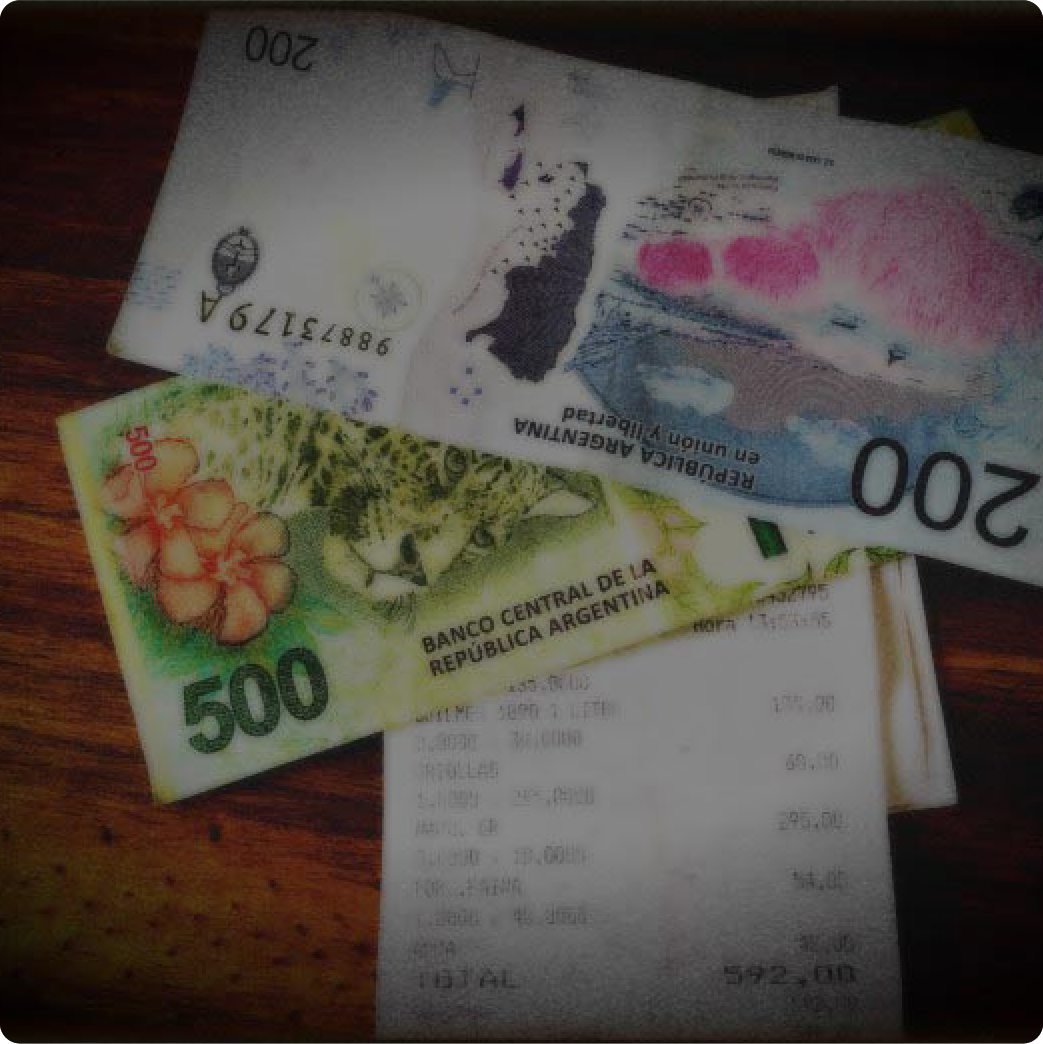



Looking for the best exchange rate in Argentina? What’s the blue dollar rate? Should you bring Argentine pesos with you or exchange cash in Argentina? How can you avoid the expensive ATM fees? Argentina’s economic situation is constantly changing, but one thing has remained the same over the years: Cash is king in Argentina. Follow this thorough guide so that you can maximize your foreign currency value in Argentina.
RULE #1: CASH IS KING
Argentina isn’t just a cash friendly country, sometimes it’s cash demanding where many places will ONLY accept cash as payment. (In Spanish, cash is called efectivo). That’s why it’s important to carry at least a day’s worth of expenses with you as a just in case. For getting local Argentine Pesos cash you have 2 main options: ATM withdrawal and money exchange.
Update (April 2024): Since writing and rewriting this article many times over the past 10+ years the one thing that remains the same is that Argentina’s economic situation is complex and dynamic. Historically there is often a large difference between the official and blue dollar rate (explained below). The government has been successful in implementing new measures for foreign credit cards to automatically receive the “MEP Dollar” rate, an exchange rate close to the blue dollar rate. Visa and Mastercard have both been confirmed, Amex is still pending. Do note however that many locations do not accept credit cards, only debit and cash so the blue dollar rate will still play a role in your travels here.
Update (Feb 2023): Travelers have reported Visa off and on returning to the official rate abruptly after a loophole was discovered internationally for purchases globally. Mastercard appears to be initially charging at the official rate and then correcting to the MEP rate a few business days later. Keep an eye out on your credit card statements.
There are two banking systems in Argentina; Banelco and Link. Most foreign debit and credit cards work with the Banelco system so try the HSBC, Galicia, Banco Frances and other banks that utilize Banelco.
Max withdrawals are limited to roughly $100 USD equivalent in pesos (possibly less depending on the bank) per transaction with a maximum of 2 transactions per day. So per day you can withdraw about $150-200 USD worth of pesos maximum. However, at both Banco Frances and Banco Galicia travelers are able to withdraw a bit more per transaction. It is best to try when the ATMs are relatively full though. Do pay attention to the current circumstances of the blue dollar and official rate circumstances spread. Presently (April 2024) there are now reports of some debit cards receiving the “MEP” rate so pay close attention to your bank statement and what rate you are receiving if you try withdrawing pesos at an ATM here. If you are receiving the official rate with ATM withdrawals then you are receiving roughly half of the blue dollar and MEP rates.
ATM fees are pricey in Argentina averaging out at approximately $6 USD $11 USD per transaction (Dec 2019). Now you see why many travelers going to Argentina bring so much cash USD or Euros!
Tips, hacks and word to the wise:
No USD in the ATMs: Despite many ATMs around Buenos Aires giving a US Dollars option they have not spit out the greenbacks in over a decade. US Dollars can only be had at banks if you are exchanging as an account holder and presenting your paycheck. The amount you can officially buy is greatly limited (approx $200 USD per month) which is where the blue rate was born. It is rumored that when leaving the country and showing your plane ticket + passport at the Banco Nacion EZE branch you can exchange some pesos back to USD, but emphasis is on the rumor (we have yet to hear a success story).
If you need USD, you’ll have to go to a private exchange house and buy them at the blue rate like the vast majority of the population do.
Don’t forget your card! The ATMs here spit out cash first and then your card when you decline to do another transaction.

Official exchange rate: The easiest and most hassle free foreign currency exchange can be done at the international airport at the Banco Nacion branch. Do not bother with the money exchange booths as rates will be worse than what you get from the ATM. Bank policies have varied over the years as to whether a non-account holder can exchange money at a bank branch, so bring your passport or copy of your passport and some patience. But before doing so, you’ll need to check what is going on with the parallel, or blue dolar rate.
Blue dollar rate: What has likely lead you here is the mysterious and often lucrative Blue Dollar exchange rate. There is a parallel exchange rate for US Dollars and Euros meaning that there are two exchange rates you can access. There is an official exchange rate which you get from the ATMs or exchanging money at banks, and an unofficial exchange rate you get for cash at currency exchange houses, Western Union, Moneygram, etc. The parallel rate A.K.A. the “Blue Dollar” rate varies and can be as much as 100% more than the official rate. Example: You withdraw $1 USD at an ATM with your card and receive $100 pesos. You exchange $1 USD in cash at an exchange house for $200 pesos. You have an extra $100 pesos to spend.
Why does the Blue dollar rate exist and where did it come from?
In an effort to protect the local economy the government caps the amount of US Dollars the Argentine population can purchase. Presently (January 2020) the government implemented a $200 USD maximum that Argentines can purchase…officially. Where there are limits, there will be demand.
The Argentine government has also implemented a foreign purchase tax for the local population in another effort to keep cash in Argentina. Any Argentine issued credit or debit card used for purchases outside Argentina are greeted with an additional 30% tax when it comes time to pay the bill! The Argentines who plan on traveling internationally will want US Dollars or Euros cash to avoid this extra tax. Bonus info: This extra tax is also applicable to foreign services such as Netflix and Spotify.
You can exchange your Euros or USD at the Blue Dollar rate at a “cueva” (cave) or an underground exchange house. It may sound sketchy, but it’s very common and ironically more convenient — these cuevas are found through out the city and have a heavy concentration on Florida pedestrian street in Centro. You’ll hear people yelling out cambio (cam-bee-oh) and discretely offering rates if you express interest. To find exchange houses closer to you if you are outside the Centro area try searching Google Maps for “Casa de cambio near me”. Western Union and Moneygram offices will also exchange at roughly the blue dollar rate.
Get an idea of how much exchange rates will be by checking the blue dollar exchange rate here. It changes daily, sometimes 2-3 times a day and you should get something between the buy and sell rate.
In recent times (2021-2025) Western Union and Moneygram have become one of the more convenient and common ways for the long term tourists and expats to access the blue dollar rate. Making a transfer from your bank back home to a Western Union office in Argentina usually takes a couple of days, but you do get a competitive blue dollar rate. You may need to ensure the office has enough cash on hand though which is an issue often cited on forums. Less than $500 USD should prove successful.
Tips:

Speaking of tipping, there are no credit card tip lines on receipts. So even if you plan on paying for a meal with a credit card bring some cash along for tips. (In the 1990s-2000’s the waiter would ask customers directly if they wanted to add a tip in the total. Eventually cash tips simply became commonplace to avoid the awkwardness.)
For more info on when and how much to tip in Argentina.
We suggest signing up for a card with no foreign transaction fees. All major banks and credit card companies have an option and if you plan on traveling in Argentina for more than a week these fees will add up!
There has been a long ongoing saga of credit card companies and their fees in Argentina. To make a long story short a lot of restaurants and shops will simply not offer a credit card payment option or claim that their credit card system is “offline”. A combination of a 3-6% credit card fee to the merchant, a foreign money conversion fee, plus the sale being fully taxed at 21% makes many stores avoid credit cards like the plague. If you are low on cash, beware.
Taxis, many stores and restaurants do not accept cards so always have some cash on you. Even USD would be better than nothing.
Good back up plans:
-Uber it! Set up Uber in advance. Since UBER is frowned upon by the taxi union, expect to sit up front and play it cool. There is always public transportation which will require a SUBE card.
-Always carry a couple of spare $50 USD bills
-Consider using Xoom, Western Union, Moneygram or for transfers directly from your bank to offices here in Buenos Aires. Cash can be picked up during their business hours in USD (sometimes) and local pesos at their rate, usually at or above the blue rate.
-And now to top it all off and make you slightly paranoid, beware of Fake bills and counterfeit currency
(US) 910 795 2992
(AR) +54 9 11 —- —-
©Copyright 2025 Landingpadba, LLC